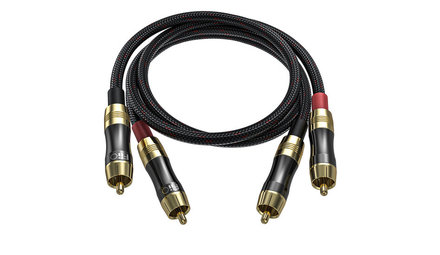

- 6500+ reviews score 9.4 average
- Free shipments over 50 euro in The Netherlands and Belgium
- Shipment in the EU
AudioQuest Boxer
SOLID 1.25% SILVER CONDUCTORS: Solid conductors eliminate strand-interaction distortion and reduce jitter. Solid silver-plated conductors are excellent for very high-frequency applications. These signals, being such a high frequency, travel almost exclusively on the surface of the conductor. As the surface is made of high-purity silver, the performance is very close to that of a solid silver cable, but priced much closer to solid copper cable. This is an incredibly cost effective way of manufacturing very high-quality subwoofer cables.
POLYETHYLENE AIR-TUBE INSULATION: Any solid material adjacent to a conductor is actually part of an imperfect circuit. Wire insulation and circuit board materials all absorb energy (loss). Some of this energy is stored and then released as distortion. All of Boxer’s conductors use PE Air-Tube Insulation because air absorbs next to no energy, and Polyethylene is low-loss and has a benign distortion profile. PE Air-Tube Insulation causes much less of the out-of-focus effect common to other materials.
CARBON-BASED 3-LAYER NOISE-DISSIPATION SYSTEM (NDS): 100% shield coverage is easy. Preventing captured RF Interference from modulating the equipment’s ground reference requires AQ’s Noise-Dissipation System. Metal and Carbon-Loaded synthetics prevent most RFI from reaching the equipment’s ground plane.
DOUBLE-BALANCED GEOMETRY: Electrically separate shield better preserves integrity of the negative conductor.
COLD-WELDED HANGING-SILVER DIRECTLY OVER PURE RED COPPER SYSTEM: This plug design enables a perfect heat-free connection between cable and plug. The connection between the plug and conductors is made using AQ’s Cold-Welded System, which provides a superior connection that ensures that the structural integrity of the conductor is kept completely intact. The Cold-Welded System refers to a combination of high pressure at the point of contact and the use of copper- or silver-impregnated paste. (Boxer’s silver conductors get silver paste.)
GROUNDING: Sometimes there is a hum problem unless the subwoofer and AV receiver (or surround-sound processor) are attached to each other using a separate wire. If your system has a hum problem, try attaching the little spade-lug tails to the metal chassis of the subwoofer amplifier and to the chassis of the sending component. Usually, this extra wire will not be needed.




